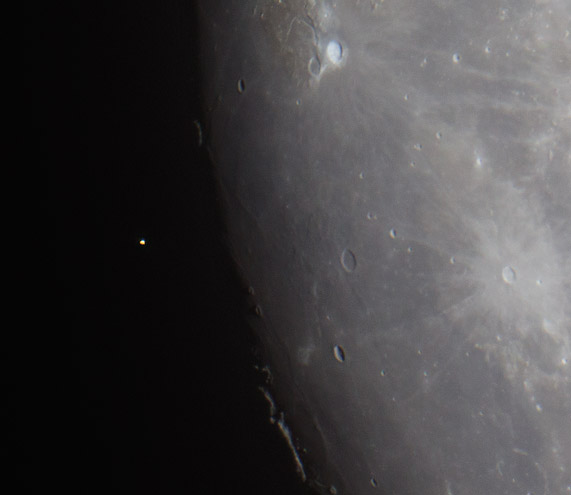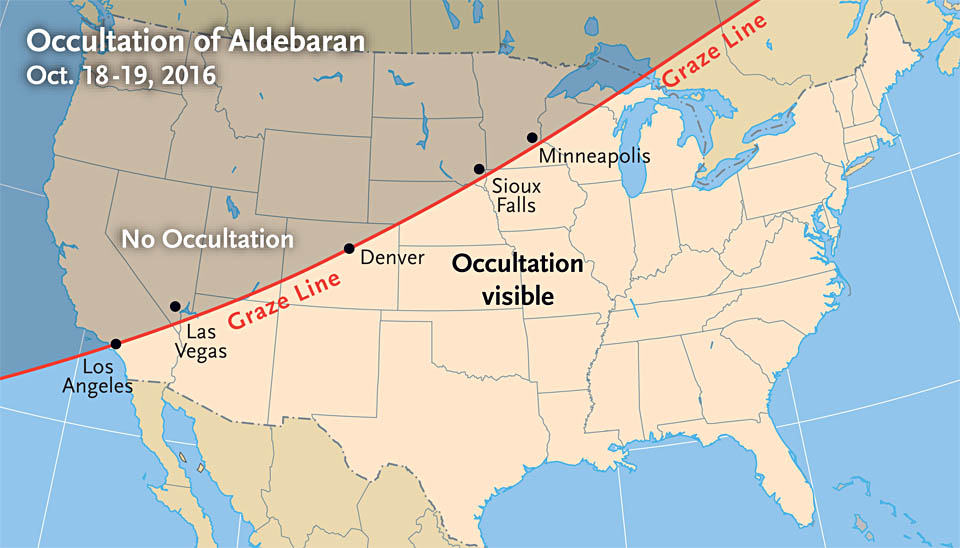This eye-catching occultation occurs late on October 18th (West Coast) and early on the 19th (East Coast). It's a grazing event as seen from Los Angeles and Denver.

Have you caught an occultation of Aldebaran yet? They're happening every 27 or 28 days, once per lunar month, in a long series that began on January 29, 2015, and ends on September 3, 2018. But most occur for parts of the world where you are not, or in the daytime, or with the Moon too close to the Sun. And then when everything comes together, it's often cloudy.
Skywatchers in much of North America have their next good chance late on the night of October 18-19, when the waning gibbous Moon (86% sunlit) will cross Aldebaran after midnight for the East, and in late evening for the Southwest. The map below shows the large area of visibility. Aldebaran will disappear on the Moon's bright limb, for which you will need a telescope at high power, then will reappear from behind the Moon's invisible dark limb up to an hour or so later. For the reappearance, binoculars should be enough.
Here are event times for some representative cities:
| Occultation of Aldebaran on October 18–19, 2016 | ||
| City | Disappearance | Reappearance |
| Halifax | 3:06 a.m. | 4:08 a.m. ADT (on October 19th) |
| New York | 1:44 a.m. | 2:50 a.m. EDT |
| Washington | 1:36 a.m. | 2:44 a.m. EDT |
| Atlanta | 1:18 a.m. | 2:27 a.m. EDT |
| Miami | 1:11 a.m. | 2:26 a.m. EDT |
| Toronto | 1:48 a.m. | 2:37 a.m. EDT |
| Chicago | 12:37 a.m. | 1:20 a.m. CDT |
| Kansas City | 12:28 a.m. | 1:08 a.m. CDT |
| Austin | 12:03 a.m. | 1:03 a.m. CDT |
| Phoenix | 10:13 p.m. | 10:42 p.m. MST (on October 18th) |
| San Diego | 10:14 p.m. | 10:36 p.m. PDT |
Click here for times and additional details for 1,000 cities and towns. (Note: Universal Time is used in that tabulation; you'll need to convert to your time zone for local predictions.)
A Populated Graze Line
The most interesting place to be will be in a strip a few hundred yards wide along the graze line. This graze zone runs right across Los Angeles and Denver, about 50 miles southeast of Las Vegas, and about 30 miles southeast of Minneapolis. The narrow graze zone is plotted to street-level accuracy (along with how to correct for your elevation) on this special webpage.

Sky & Telescope diagram / source: IOTA
Along that line, you'll probably see Aldebaran disappear and reappear several times in the darkness just barely off the Moon's dazzlingly sunlit north polar region. Most of the events will be gradual rather than instantaneous, as hills and valleys on the Moon's northern limb slide across the face of the giant star. Aldebaran's disk is 20 milliarcseconds wide, or 40 meters wide at the Moon's distance.
The graze "could be an interesting opportunity for public outreach," says David Dunham of the International Occultation Timing Association (IOTA), "a rare astronomical phenomenon visible with binoculars by thousands of people who live in the graze zone. In spite of the bright Moon, this is one of the better Aldebaran events in the current series for populous parts of North America."
If you think they're becoming routine, enjoy the ones you can while you can. We're halfway through the current series, and after September 2018 the Moon will not occult a 1st-magnitude star until 2023 (Antares, on August 25th of that year), and the next Aldebaran series won't start until 2033.
Hyades Stars
For much of the U.S. and Canada, the 4th-magnitude Hyades stars 71 Tauri, ZC 677, and Θ1 and Θ2 Tauri will reappear from behind the Moon's dark limb 2 to 4 hours before Aldebaran does. Detailed predictions for these stars are also available: 71 Tauri, ZC 677, Θ1 Tauri, Θ2 Tauri.
 1
1
Comments
Joe Stieber
October 19, 2016 at 9:51 pm
Where it says you'll need a "telescope at high power," I was wondering what constitutes high power? Using an 80 mm refractor, I had no trouble seeing Aldebaran about 10 minutes before disappearance using 27x, but for a better view of the disappearance and reappearance, I used 55x and it was easy to see Aldebaran. 55x doesn't seem like particularly high power to me. About 10 minutes after reappearance, I was able to spot Aldebaran with unaided eyes (albeit, I had to look carefully).
You must be logged in to post a comment.
You must be logged in to post a comment.